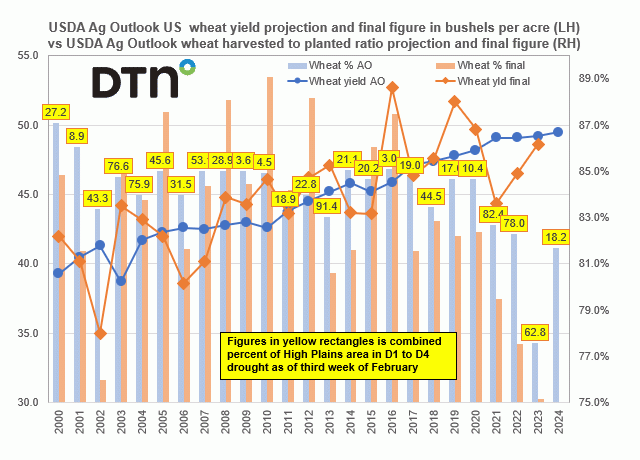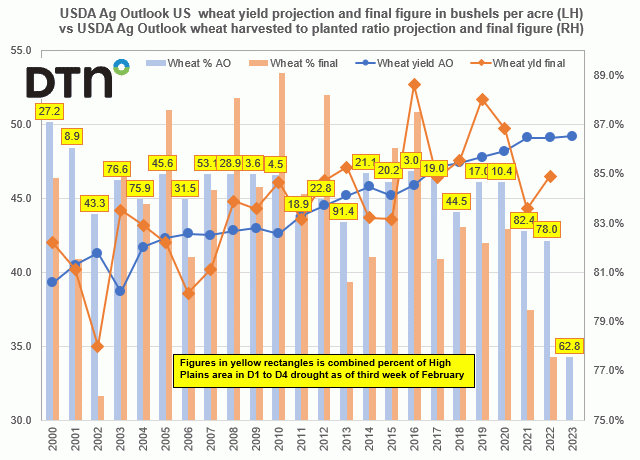Fundamentally Speaking
USDA Expecting Normal Wheat Abandonment Rates
At the recent USDA Ag Outlook Forum (AO), department economists indicated of the three main crops, wheat area is projected to decline the most with relatively favorable prices for competing crops such as cotton and sorghum.
Total wheat planted area for 2024/25 is projected at 47.0 million acres, down 2.6 million acres from last year.
This is based on the NASS winter wheat seedings report released last month which estimated winter wheat seeded area at 34.4 million acres, down six percent from 2023.
Combined spring and durum wheat plantings for 2024/25 are projected slightly lower than last year with area constrained by relatively higher expected net returns for soybeans, minor oilseeds, and other crops in the Northern Plains.
Harvested area is forecast at 38.4 million metric tons (mmt)and is based on the 10-year average harvest-to-plant ratio.
P[L1] D[0x0] M[300x250] OOP[F] ADUNIT[] T[]
While planted area is forecast to be lower than the previous year, harvested area increases year-to-year, as abandonment is expected to return to normal levels following two years of drought conditions in the Southern Plains.
In fact, last year's 75.2% harvested to planted ratio was the lowest since the 1937 Dust Bowl season.
The all-wheat yield for 2024/25 is projected to be up two percent from last year at 49.5 bushels per acre and is based on a long-term linear trend.
This chart shows the USDA Ag Outlook U.S. wheat yield projection and final figure in bushels per acre (bpa) on the lefthand axis vs the USDA Ag Outlook wheat harvested to planted acreage ratio projection and final figure on the righthand axis.
The figures in the yellow rectangles are the combined percent of High Plains area in D1 to D4 drought as of third week of February.
The USDA's projected 81.7% harvested to planted ratio for 2024 is higher than the final harvested/planted ratio of the past three years as this is linked to rather poor weather in both the major winter and spring wheat producing states over the past few seasons that has capped yield potential also.
The USDA AO yield estimate of 49.5 bpa is also the highest one ever projected at the Ag Outlook as that much higher predicted harvested to planted acreage ratio is no doubt linked to much better growing conditions in some of the key winter wheat producing states.
Note that the combined percent of the area in the High Plains where a lot of the winter wheat is grown in a drought category ranging from D1 (which is moderate) to D4 (which is exceptional) along with D2 severe and D3 extreme is just 18.2%, down sharply from the year ago figure of 62.8%, 78.0% in 2022 and 82.4% the third week of February 2021.
There is still a long way to go but so far what looks like decent winter wheat production is linked to good yields and a far higher harvested to planted ratio than a year ago, even with lowered seeded area.
These are among the reasons why Kansas City wheat is now trading at lowest levels in about three years.
(c) Copyright 2024 DTN, LLC. All rights reserved.





Comments
To comment, please Log In or Join our Community .